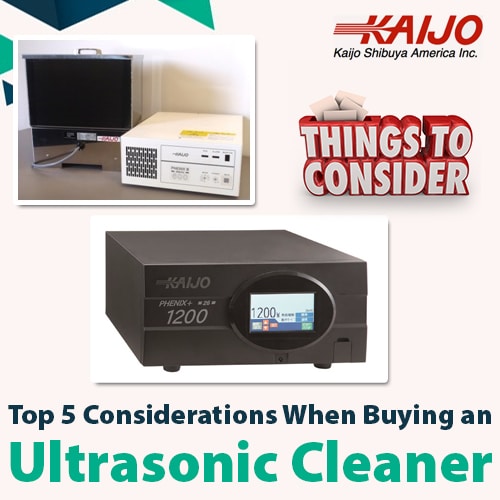Top 5 Considerations When Buying an Ultrasonic Cleaner
June 9, 2022
 When the characteristics of industrial ultrasonic cleaning systems match the requirements of the cleaning application, ultrasonic cleaners can outperform conventional cleaning methods. A properly configured ultrasonic cleaner can clean more quickly and completely than methods using manual scrubbing, pressure washing, and soaking in toxic chemicals. Key characteristics that will help the ultrasonic cleaning system deliver excellent cleaning performance include the frequency, size of tank, power, cleaning solution, and operating temperature.
When the characteristics of industrial ultrasonic cleaning systems match the requirements of the cleaning application, ultrasonic cleaners can outperform conventional cleaning methods. A properly configured ultrasonic cleaner can clean more quickly and completely than methods using manual scrubbing, pressure washing, and soaking in toxic chemicals. Key characteristics that will help the ultrasonic cleaning system deliver excellent cleaning performance include the frequency, size of tank, power, cleaning solution, and operating temperature.
1. The Best Frequency to Use
a. Low Versus High Frequency
The microscopic cavitation bubbles produced by low ultrasonic frequencies are comparatively large and energetic. Their powerful cleaning action is suitable for cleaning off stubborn contaminants on hard materials that are not easily damaged. High frequencies produce smaller bubbles and a gentler cleaning action that is suitable for soft materials, materials with a delicate coating, and for textured surfaces or surfaces with fine structures.
b. Do You Need Programmable Frequency Modulation?
Kaijo’s ultrasonic Phenix+ systems have Programmable Frequency Modulation capability. This functionality forms a strong leading edge on the waveform, delivering an increased ability to clean hard-to-remove contaminants.
2. Cleaning Tank Size
Tanks must be sized to hold the parts to be cleaned completely submerged in the cleaning solution. For many small parts, a basket may be needed to keep the parts suspended. Tank size is also determined by whether the direct cleaning method or indirect cleaning is used.
a. Direct Cleaning Method
With the direct cleaning method parts to be cleaned are placed directly in the main cleaning tank and completely submerged. The tank must be big enough to submerge the largest part.
b. Indirect Cleaning Method
A smaller container, large enough to hold the parts to be cleaned, may be placed inside a larger ultrasonic tank. The smaller container is filled with the chemical cleaning solution and the larger tank is partially filled with water. This way, the amount of cleaning chemical required is reduced as the ultrasonic waves will pass through the walls of the smaller container to facilitate the cleaning process.
3. Cleaning Power
Turnkey ultrasonic cleaning systems are designed with the right amount of power, but if the components of the system are purchased separately, it’s important that the transducer generate enough ultrasonic waves to completely fill the tank. If the system doesn’t have enough power, cleaning may be uneven because the tank will have dead spots where the ultrasonic waves don’t penetrate.
For larger tanks, more than one transducer may be required to ensure even cleaning. An experienced manufacturer of ultrasonic cleaners can advise on what power levels are adequate and what configuration of transducers is suitable for larger tanks.
4. Cleaning Solutions You Need to Use
Most parts can be cleaned by using only deionized water as the cleaning solution, but heavy contaminants can be removed more easily by adding detergents or mild solvents. Sometimes a specific hard-to-remove contaminant can be dissolved using a special chemical, and cleaning oily or greasy residues is easier with detergents or soaps. In general, tough cleaning applications can be completed more quickly and completely with the addition of mild solvents or detergents to the cleaning solution.
5. Do You Need Heat to Improve Cleaning Performance?
Removing carbon deposits and hardened grease or grime can be improved by heating the cleaning solution. Parts with contaminants that soften when heated can be cleaned more quickly at high temperatures. When the cleaning solution is heated to just below boiling, the contaminants become softer and complete cleaning is done faster.
For cleaning applications using a heated cleaning solution, the ultrasonic cleaning tank is fitted with a heater and a temperature controller to keep the temperature at the set point and prevent overheating. The tank and the parts to be cleaned must be able to withstand the set temperature and the ultrasonic transducers immersed in the cleaning solution must be capable of high-temperature operation.
Do You Need Help Selecting an Ultrasonic Cleaning System?
Kaijo has in-house expertise and extensive experience in ultrasonic cleaning technology to help customers choose the best system for their cleaning applications. Contact Kaijo to discuss your cleaning application to get the guidance you need. Kaijo provides free consulting and can recommend systems from its complete line of turnkey systems and components.





